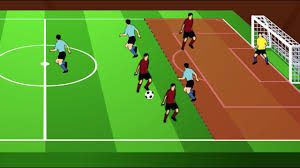The Offside Rule and Offside Trap in Football(Soccer)
It is not an offense in itself to be in an offside position.
A player is in an offside position if:
- he is nearer to his opponents’ goal line than both the ball and the second-last opponent
A player is not in an offside position if:
- he is in his own half of the field of play
- he is level with the second-last opponent
- he is level with the last two opponents
Committing an Offside Offence
A player in an offside position is only penalized if, at the moment the ball touches or is played by one of his team, he is, in the opinion of the referee, involved in active play by:
- interfering with play
- interfering with an opponent
- gaining an advantage by being in that position
No Offence
There is no offside offense if a player receives the ball directly from:
- a goal kick
- a throw-in
- a corner kick
Infringements/Sanctions
For any offside offense, the referee awards an indirect free kick to the opposing team to be taken from the place where the infringement occurred.

This is offside because the red number 10 is in front of all of the defenders, leaving only the goalkeeper back which isn’t enough players to play him onside. This position may have been forced by the defenders moving forward in what is called the offside trap.

Here we can see that the blue number 3 defender has failed to move up the field with the rest of his defense and played the red number 9 onside. This is a classic example of where the offside trap fails

The offside rule exists to stop goal hanging, where a player stands next to the opposing teams’ goalkeeper in the hope that someone can get the ball to him (probably using a long ball), so he can get it past the goalkeeper. Which would make for a very boring game?
![]()
The red number 9 isn’t beyond the blue 4 defenders but is offside because the goalkeeper isn’t back. This is one of those rare occasions where the goalkeeper is out of the goal (e.g. last minute of F.A. Cup final on a corner kick) and can’t get back in time but if the attacking team play the ball as they normally would, then it would be offside because the offside rule requires two defenders to be in front the attacker and the goalkeeper usually counts as a defender.
Why are linesmen (assistant referees) always calling offside when it isn’t? Well believe it or not it is not really their fault (unless the decision goes against you or your team), it’s all to do with angles and line of sight. In the picture the purple line represents the linesman’s line of sight which as you can see is at a slight angle, this line should be parallel with the goal line. So even though the red number 10 is being played onside by the blue defender it will be called offside. This is unfortunate but does happen from time to time.
If you’re one of the millions of people who only watch soccer every four years, the offside rule can be pretty frustrating. It’s one of the most important rules of the game, and the margin between the onside and off is often razor-thin. The offside rule prevents players from cherry-picking, and forces attacking players to make perfectly-timed runs toward the goal, rather than just camping in the penalty area.
Mexico had two goals disallowed for dubious offside calls in its opener against Cameroon, and Switzerland had a goal taken away controversially against Ecuador. In the three games Monday, offsides was called a combined 10 times.
Here’s the entry for offside directly from the FIFA rulebook:
A player is in an offside position if he is nearer to his opponents’ goal line than both the ball and the second-last opponent
A player in an offside position is only penalized if, at the moment the ball touches or is played by one of his team, he is, in the opinion of the referee, involved in active play by:
- interfering with play or
- interfering with an opponent or
- gaining an advantage by being in that position
An offside violation occurs the moment when the ball is played forward to a player in an offside position. It’s much easier to grasp with a visual example. This is all you really need to know:
There are a few exceptions. Players cannot be penalized for being offsides during throw-ins, corner kicks, and goal kicks. Furthermore, players will not be called for offsides if they have no impact on the play.
Still a little foggy on the rule? Here’s an explanation from a 9-year-old girl.
